Jade: properties, colors, types and applications
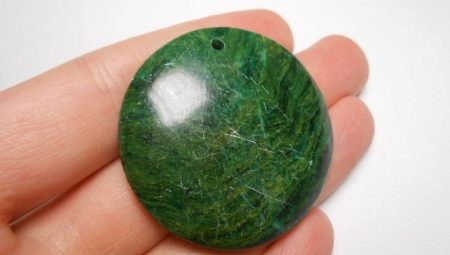
Precious and semiprecious stones have been highly valued since ancient times - in the era of the absence of plastic and other bright and durable materials, it was these minerals that diluted the dullness and monotony of life. One of the most famous stones has always been jade, which is still very popular today.


What it is?
The description of jade should start with the fact that in its raw form, this gem looks relatively unattractive - a modern man could mistake it for a piece of green bottle glass of a strange shape. Moreover, such a mineral is much stronger than glass (in this regard, it even surpasses granite), but it is curious that stone processing is relatively simple. The resulting products show impressive durability, not to mention the fact that when polished, a piece of jade acquires a very delicate green overflow with interspersed with other shades - this makes it a jewel.
Another proof of the reliability of jade products is that even today archaeologists find various amulets and figurines from it, dating back to millennia BC.
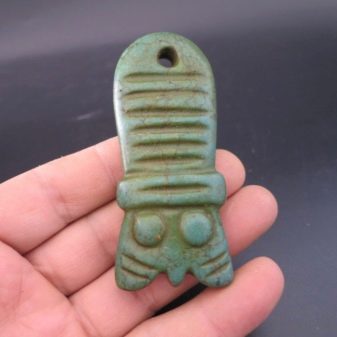
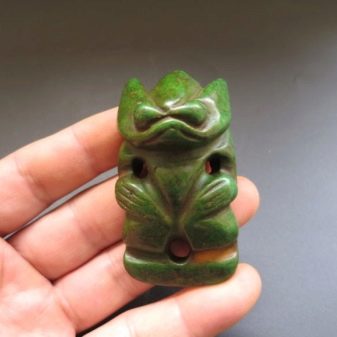
Because of its reliability, the mineral could have a practical value, for example, in the same Ancient Egypt, household items were sometimes made from it, although they, of course, were not cheap. In addition to the actual jewelry, jade chips were also used to cover clothes. Sometimes especially large crystals were used even in the construction of buildings.
Chemically, jade is a complex compound, which contains atoms of calcium, magnesium, iron, silicon, hydrogen and oxygen. The resulting rock is characterized by high toughness at the level of steel and similar strength.


In public opinion, jade is often associated with shades of green and this is indeed the most common color, but the color range of the mineral is much wider. In fact, the stone can even be white or black, although light greenish notes are almost always present anyway.
What's curious the most valuable is the pale green variety with a characteristic oily sheen and significant transparency. In this case, the thickness of the stone may not transmit light at all until a large piece is cut into thinner plates. Among other things, jade also has a high heat capacity, so it can be productively used as a heating pad.
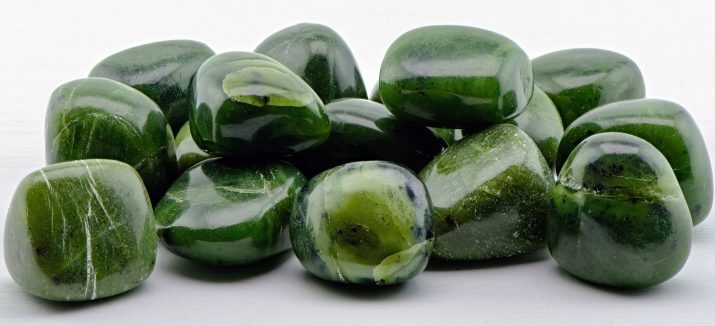
Place of Birth
For nephrite (and some other minerals similar to it) to form, it is necessary for the incandescent magma to penetrate into the sedimentary rocks - this is the way of occurrence recognized by geologists as the most common. Alternatively, the same magma should penetrate into serpentinite deposits.
Jade deposits are inextricably linked with deposits of shale and marble. As a rule, this mineral is mined either in placers at the bottom of reservoirs with flowing water, or in jade quarries. Industrial mining of precious stones is possible on any continent. In Russia, the current Ospinskoe field, as well as the already exhausted Ulan-Khodinskoe. In addition, there are sources of the valuable mineral and in Tuva, and in the Northern Urals, and in neighboring Kazakhstan.

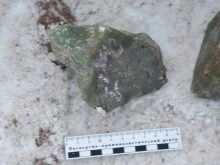
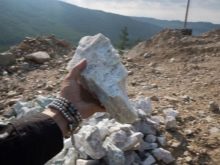
If we consider other states, then a lot of high-quality jade is mined in New Zealand - the stones there are good not only from a practical, but also from an aesthetic point of view. Large deposits are located and in North America - in the states of Alaska, Montana, California and Washington, as well as in Canada. Another major jade miner is China.
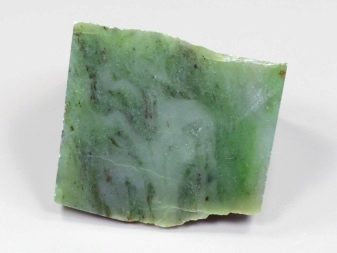
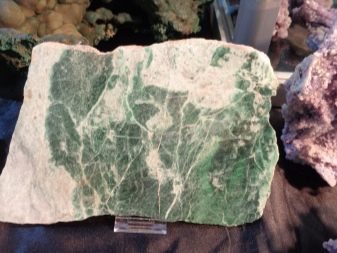
Meaning for a person
In different cultures and at different times, jade could have different meanings, but in many regions it was perceived and perceived as a symbol of power. Many peoples associate soft green tones with life, respectively, such a power is kind, it protects its people from harm.
In China, this stone is literally considered a national symbol; it is still very common as a popular material for making gift souvenirs. The Chinese believe that jade is capable of changing human behavior, therefore, products are often presented with symbols of one or another good. So, a peach applied to a jade product symbolizes longevity, a fish means wealth, a bat is a wish for good luck, etc.

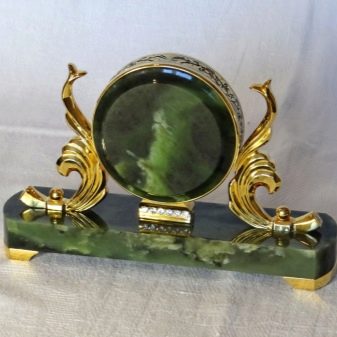
In general, in the East, jade was associated with harmony, tranquility, deliverance from worldly vanity. This is not surprising, because psychologists have long proven that green tones in the design of something have a pronounced calming effect. In Europe, deep jade green was associated with something else: a specific shade was associated with magic, therefore the stone was in demand by fortune-tellers and other mystifiers.
The Maori indigenous people of New Zealand made extensive use of jade products in their religious rituals. Representatives of this ethnic group still consider this stone one of the main symbols of their native country, and since 1997, the local government even transferred all local deposits of this stone to the management of the indigenous islanders.

Properties
Since ancient times, various medicinal and even magical properties have been attributed to this mineral, which made the stone even more expensive.The modern name of the breed comes from the Greek word "kidney", in particular, because the mineral was actively used to treat diseases of this organ and the bladder. The beneficial properties of jade for the body also include a positive psychological effect - jade product eliminates any anxiety, insomnia and nightmares.
The healing effect is also noted for the digestive system.


The real benefits of jade is that it, unlike many other stones, is never cold - this rock keeps heat well. Before using it as a heating pad, it is additionally warmed up, but then it maintains a given temperature for a long time and allows the abdominal cavity to be warmed up, which, in case of many symptoms, really has a beneficial effect.
Among other things, even today you can get to a massage session performed using special jade balls. It is noted that from a cosmetic point of view, the condition of the skin is clearly improving.
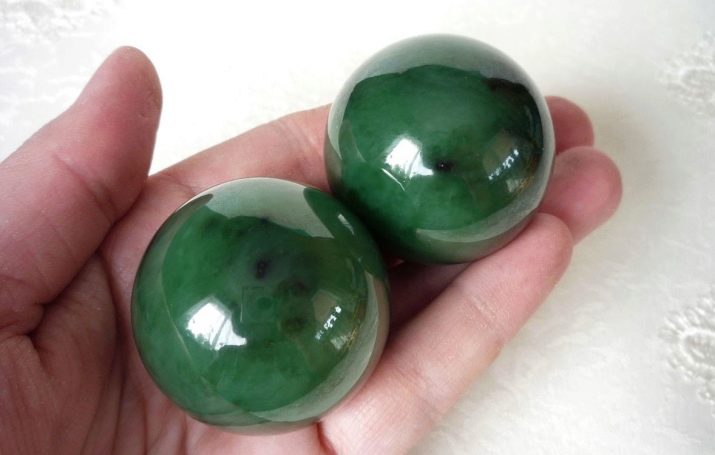
Also jade is still used today. in various magical rituals. According to the Chinese concept of the universe, this stone symbolizes the transparency of Heaven and the hardness of the Earth. Among other things, it is also a symbol of Eternity and Wisdom. Confucius, being a philosopher and not a magician, endowed jade products with the ability to reveal the mental abilities of the owner, as well as help maintain prudence and a humane approach in all situations.
In the European tradition, jade is more a way of communication with other worlds. Some authorities in the world of magic and esotericism claim that this the stone is also an excellent countermeasure for any natural disasters... If we talk about an individual person, then for him it is a good amulet against the evil eye, he also effectively protects against enemies and getting into a bad company. Jade is also said to help build strong and trusting relationships within the family.

Varieties
The color range of jade is quite extensive: contrary to popular belief, it does not have to be green at all. The classification of species is often made according to the color of the stone, and it can be of very different shades, and such color "anomalies" are also perceived in different ways.
- White version of jade looks very unusual, from the side of the product made of it they resemble melting ice with its characteristic shine. At the same time, such a mineral (already rare) is never pure white at all - its structure almost always contains grayish, slightly yellow and greenish shades.
This includes a special shade known as "mutton fat" - in appearance, a shiny polished stone of this sort really looks like that, and in the world it is one of the most expensive types of jade.
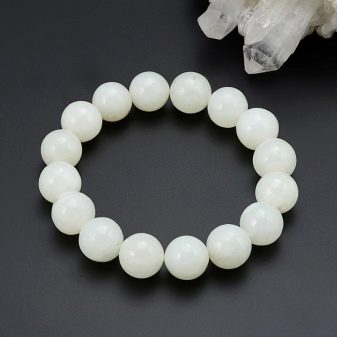
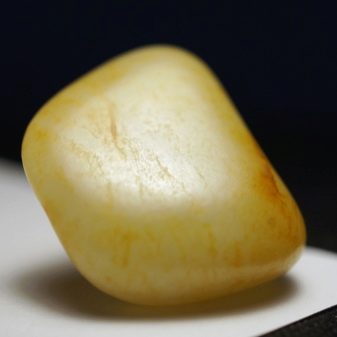
- Green jade is the most famous, but that does not make it the least in demand. In particular, for various purposes of a magical nature, just such a stone is required - its shade in the popular sense is inextricably linked with the supernatural. Most of the Chinese beliefs associated with jade amulets also relate specifically to the green varieties of the material.

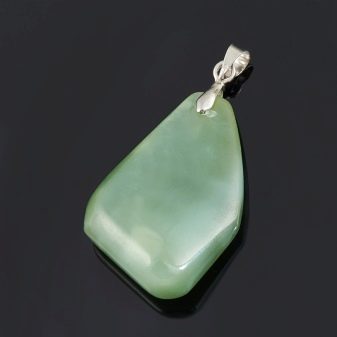
- Black stone has only a slightly noticeable greenish tint. This variety is also rare, and it is extremely rare that any specific properties are attributed to it. The main application of this material is in the jewelry industry.
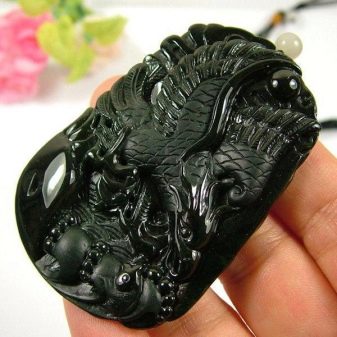
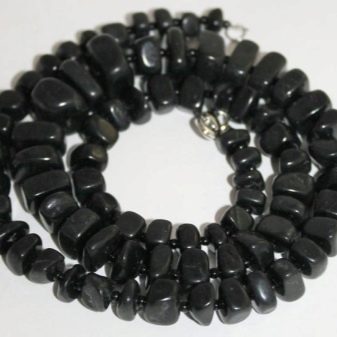
It should be noted that due to foreign impurities, the color of the jade crystal can be absolutely any - in nature there are even red, blue or pink versions of the stone. At the same time, impurities are rarely uniform, much more often they act as well-visible foreign inclusions. Of course, a homogeneous material is valued above all, especially if it has a bright tone and a high degree of transparency.
The spotted option, provided the spots are solid and evenly scattered, can also look good. Stones with situational inclusions are usually not highly valued. - an extraneous fragment spoils the overall impression of the crystal. At the same time, specific patterns on the surface of a piece of jade can be successfully beaten by jewelers, who further emphasize the beauty of Mother Nature's design.
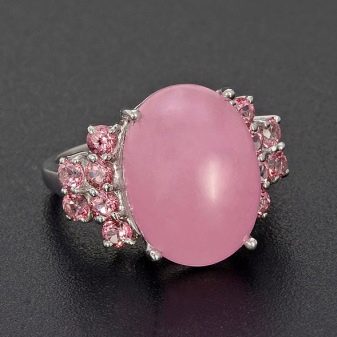
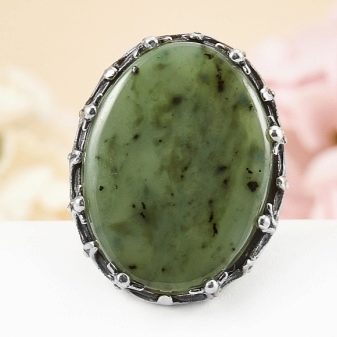
Application
In ancient times, a variety of products were made from jade: in regions where there was no shortage of such material, its strength was highly valued, therefore, even tools of labor could be made from the mineral. Today globalization has led to an increase in demand for this stone, but its reserves, naturally, have not increased, because now they usually make either jewelry or various talismans and amulets from it. Both product options should be considered in a little more detail.
In the role of a talisman or amulet, this stone apparently debuted earlier: as we see from history, both in China and in Europe special properties were attributed to it. It is generally accepted that it is a very effective talisman against failure and misfortune of any kind... Such a product can be especially effective for lonely people if white grade.
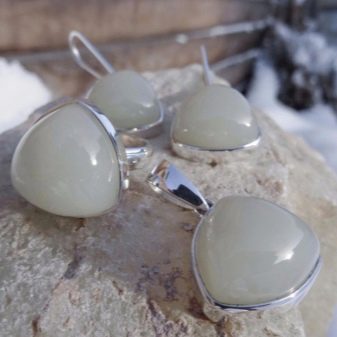

With the acquisition of such a thing, one can expect that the situation will be much better with love and marriage in the future.
Children are often presented with a jade pendant featuring a castle. This is a kind of symbol of life, a wish for health and longevity. For adults who want to achieve career heights without compromising family life, it is best suited ring inlaid with white jade.


Jade amulets are also good because they are credited with the ability to enhance the positive effects of other jewelry with esoteric overtones. By itself, the mineral allegedly stimulates the work of the mind, and also provokes displays of courage. This is not a stone for which large size is fundamentally important, on the contrary, products of modest size help the owner to outrun rivals and quickly climb up.
While greens and other most common shades of jade have a general esoteric meaning, completely different properties are attributed to the blood-red variety of the mineral. Such a stone, first of all, is considered a talisman not for a person, but for a home - it protects it from natural disasters.
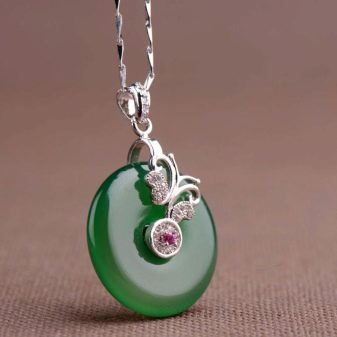
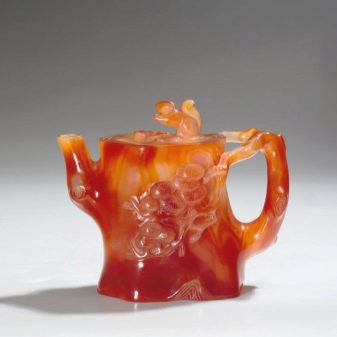
A separate use of jade is as a material for various jewelry items, especially for women. Beautiful green color with transparent tints or even extraneous "muddy" inclusions from ancient times like people, because even in ancient times this mineral was used in the manufacture of jewelry. Today, jade inserts are present in rings and bracelets, pendants and beads are made of them, and this does not always apply to the green variety. If we talk about larger jewelry, then on sale you can find jade figurinesthat can decorate any sophisticated interior.
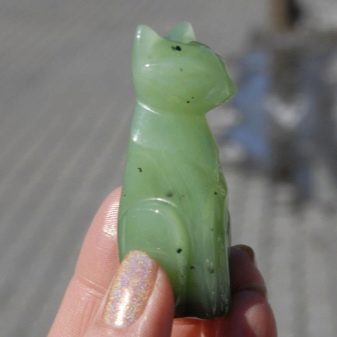
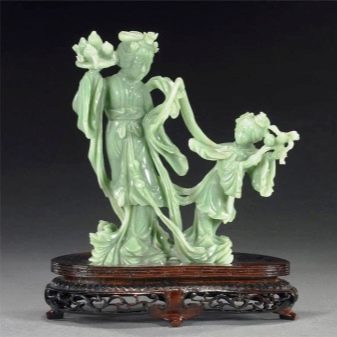
In addition to the above-described uses, other uses for jade are permitted. It was already mentioned above that this stone perfectly retains heat, at least due to this, it is used by various traditional healers in the form an analogue of a heating pad or for a specific therapeutic massage.
In addition, the impressive strength of the mineral has not gone anywhere, due to which it can be used to make almost any household items.

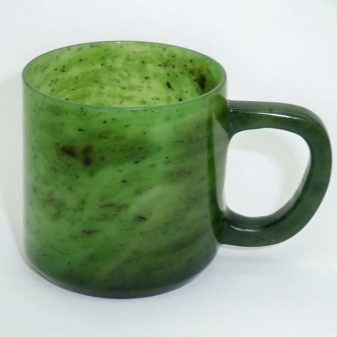
Who is it suitable for?
Jade belongs to those stones that are theoretically suitable for representatives of any sign of the zodiac, although esoteric experts warn: this mineral is capable of drastically changing your life, therefore a person who has chosen this particular material for a talisman or decoration must be ready for drastic changes in everyday life.
- If we are to be guided by the signs of the zodiac, then it is best, according to experts, jade is suitable for Libra - it calms and balances them. However, not everything is so simple, because the representatives of this zodiac sign need just not a green, but a white version of the stone.


- For Virgos, jade products are also very useful. - they supposedly should help in establishing family life, since they are responsible for love. Another thing is that an even rarer red stone is needed for the described result. A fiery mineral will have a different effect - your professional initiatives will be appreciated by your superiors.
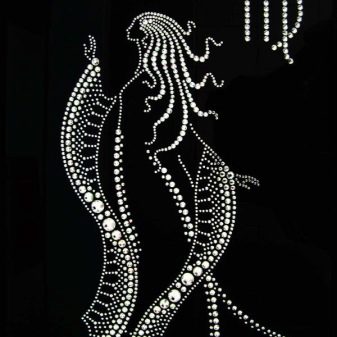
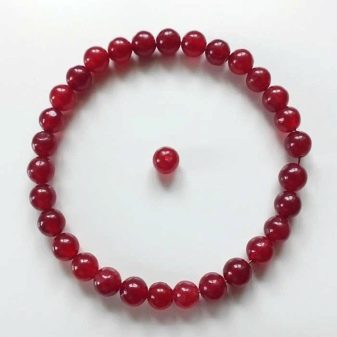
- For Cancers and Pisces the most recommended are also unusual jade shades - they give the owner of the talisman strength and energy for new achievements.


- Capricorn - the only sign of the zodiac for which the classic green jade, which is most often found in nature, is recommended. On the representatives of this zodiac sign, such a stone produces a calming effect - they become less aggressive and impulsive, due to which the likelihood of achieving their goals increases significantly.

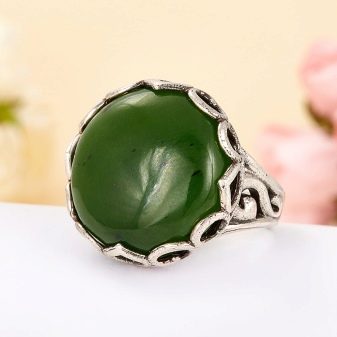
- Despite the fact that jade is considered to be a universal stone, it is least suitable for such signs of the zodiac as Taurus and Sagittarius.
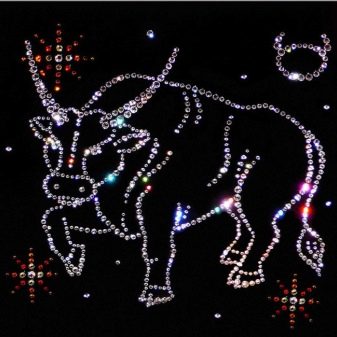

How to distinguish a natural stone from a fake?
The modern world is distinguished by a special feature - there are many fakes in it, only imitating the original. On the one hand, this is good, because poor people can now also wear decent-looking jewelry, on the other hand, scammers can deceive an inexperienced person by selling him a cheap product at a price of an expensive one. In addition to natural crystal jade, there is at least two variants of its forgery.
The first in chemical composition is still the same jade, only made from jade dust by pressing - with all other correspondences, such a production method, of course, does not even come close to the expected strength and durability.
The second is actually plastic, which only looks like the original.
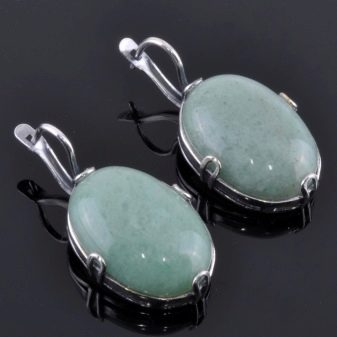
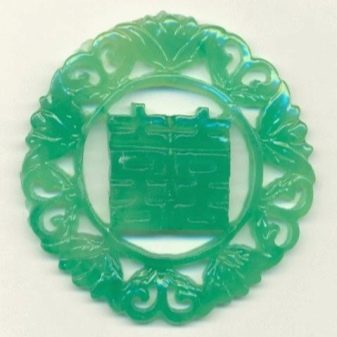
Since natural jade is not so cheap, when buying you can check its authenticity in one of several ways.
- Natural stone is as hard as steel and it is impossible to scratch it with any needle. A pressed block, not to mention plastic, will always succumb to such an effect. There is also real jade, scratched with a needle, but it's easy to draw conclusions about its quality.
- At the moment of the first touch jade is likely to feel cool unless stored in a hot room. Try to warm it in the palm of your hand and then set it aside. Check in a few minutes how the temperature of the mineral has changed: if it is real, then after 5 minutes it will still be warm.
- If you buy jade beads, it is possible to check the degree of naturalness of raw materials using sound. Here, of course, experience would not hurt, but in general they say that when two real jade beads collide, the resulting sound should be melodic.
- In case your jade product is thin enoughto let the light through, take a closer look at it. In the bright rays of a real mineral, clearly visible intertwined "fibers" should be visible in the thickness.

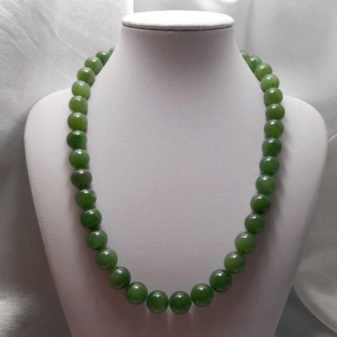
Conscientious sellers may not hide the fact that their product is artificial. At the same time, the properties of plastic are known to every modern person, but opinions differ about pressed jewelry made of crumbs and dust. On the one hand, this is still the same mineral, because its magical and medicinal properties must be preserved even despite a partial loss of strength.
On the other hand, you need to understand that the pressed stone would hardly remain intact, therefore, in a mass for a fixing effect add various extraneous ingredients like glue or plastic, due to which many properties, even purely physical, are lost.

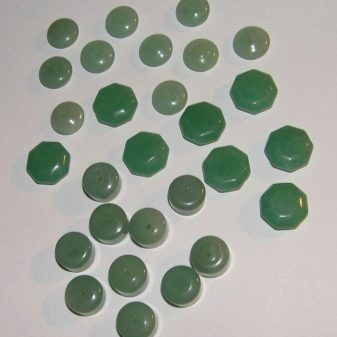
How to care?
Jade products are famous for their strength and durability, but if the owner wants to keep the little thing in its original beautiful form, there should still be minimal care for it. There are usually no difficulties with this, since an impact-resistant material is difficult to deform (unless you have a product with very tiny details), and it is quite difficult to scratch it with something sharp.
Nevertheless, it is not recommended to store a precious item anywhere, for such purposes a special hard box upholstered with a soft to the touch fabric is best suited. As an alternative storage location, you can use a special cloth bag made of dense material such as felt.
In principle, jewelry stores often use just such packaging, and if you bought a product from them, then the set probably included a container for it.


Like most stones, jade does not absorb dirt, but sometimes its surface needs to be wiped off dust and adhering dirt to restore its original shine and transparency. It is better not to experiment with caustic detergents, but an ordinary soap solution for such needs is quite suitable, but even at the end of the procedure, it must be carefully washed off under clean running water.
If the contamination is not so serious, the product does not need to be washed, confining itself to a simple wiping of its surface with a damp cloth made of soft material. To add a special shine, you can carefully rub the product with the same cloth, as if polishing it.
In addition, the following video will tell you about jade and its properties.








